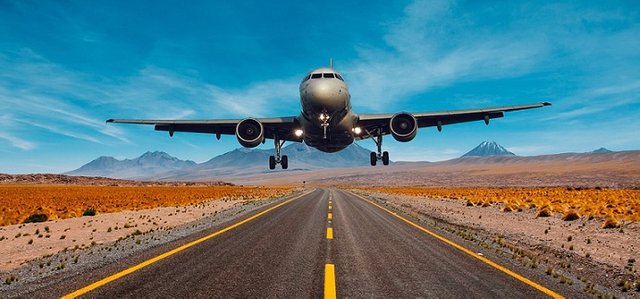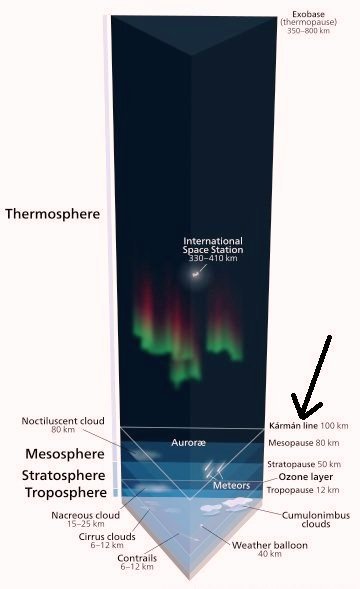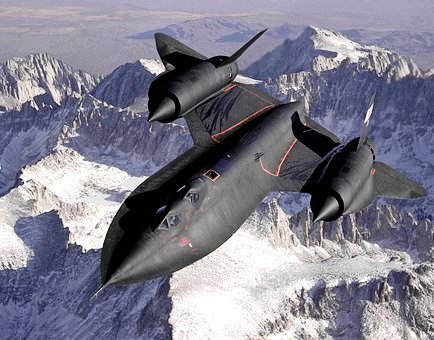Flying An Aeroplane Into Space May Be Possible In The Future, But Not Now - Let's Find Out Why
When I was a kid, I fantasized about going to the space, the reason being that I had the impression that people float around in the space. Experiencing no gravity was one of my childhood dreams and it got heightened when I watched the movie "Apollo 13". However, I didn't understand how space trips work - I only had the thought that I would walk straight to an airport, board a plane, choose "space" as my destination, and viola!! I will be in space. It was when I got older that I realized that all these were wild fantasies and you cannot fly our regular aeroplane to the space.
Introduction
Space travel has remained one of man's most outstanding achievements in the field of astro science. Way before the first space travel, it had been one of man's foremost desires, but in 1961, that desire got fulfilled and the USSR cosmonaut; Yuri Alekseyevic Gagarin found his way into space and broke the record. Soon after that, the USA landed people (Neil Armstrong, Michael Collins and Buzz Aldrin) on the near side of moon. Ever since then, space trips have been occurring frequently.

However, if you have been privileged to see a takeoff to space (like the one that was broadcast when Atlantis STS-30 left for space in 2017), you will agree with me that one very common denominator is "rocket". Now, someone might be wondering, why will it always be a space shuttle (with rocket pack), why not aeroplane, since both of them travel on the air? Or are our pilots not trained to fly into space with aeroplanes? Okay, this has nothing to do with pilots but the principles and mechanics of how aeroplanes are built. Now let's find out.
Why Not Plane?
First and most important factor to consider when you talk about aeroplane is "air". Long before the invention of plane by the Wright brothers (Orville and Wilbur), some people thought that any machine that weighs more than air cannot fly - this is due to the fact that some people have assumed that "air" is a light-weighted combination of gases. But if you look at an aeroplane, you will agree with me that it has a large span of wings. These wings are designed in a special way that when they are on air, they allow steady flow of air to pass through them at high speed to create the much needed upthrust for the aeroplane to remain air-borne.
As the flow of air beating against the wings gets increased, the plane has a propensity to go even higher. Now someone may ask "why not go higher till it goes to space?" From your knowledge of high school geography, you will agree with me that when you go much higher up the atmosphere, the concentration of air reduces, which also reduces the level of oxygen. If you have ever gone on mountain-climbing, one of the requirements is oxygen mask for this same reason: because at the peak of the mountain, the oxygen level tends to drop much lower than you can survive - this is also why jet fighter pilots wear oxygen masks because of the height they can fly.
Just as human beings breathe in oxygen to stay alive, the engines of an aeroplane breathes in (uses) oxygen to burn fuel that powers the plane and it also provides the upthrust. Y'all also know that in space, the oxygen will not be available. To make the terms very clear; any point which is beyond the Karman Line can be called space – The Karman line is located at about 100km from the earth's sea level. Even at this very point, the air has become so thin. Now I ask you; what do you think will provide the upthrust for the aeroplane?

When the plane gets to a point where the air has been completely thinned out, what do you think will happen? This is not to talk about the passengers that will be thrown into hypoxia for lack of breathable oxygen. Here's a little fun fact for you: The distance of the moon from the earth is about 384,400km [ref], but we are just talking about distance from the sea level to Karman line (start of space) - so if the moon is your destination, you have much bigger nightmare with aeroplane. Just to let y'all know, above the distance of 25km from the earth's sea level, the air concentration would have become extremely thin (this is even way below the Karman line).
One of the fastest ever recorded and highest flying manned aeroplane is the Lockheed SR-71 Blackbird with a recorded speed of 2,193.13miles/hr - but here comes another hurdle to cross. Have you ever heard of "escape velocity"? This is the effective minimal velocity that must be achieved for a body to break out of the influence of the force of gravity of the earth before going to the space. This speed is around 25,000 miles/hr. Okay the fastest jet (the Blackbird) has only about 8.7% of this speed, so how will it break through? This is not to mention your regular Boeing 747 airplanes with very minimal speed compared to the Blackbird.

The almighty Lockheed SR-71 Blackbird has fallen short of the requirements already. Well, NASA was at it, and they made a modification from Blackbird and created the NASA X-43 with about 3 times Blackbird's speed. To achieve this, they had to replace the normal air-breathing engines in Blackbird with a ScramJet Engine - with this engine, air can be compressed at high speed and even with limited supply of air. But even with the top speed of NASA X-43, it was nowhere near achieving the escape velocity, plus the plane was unmanned.
The fact is, no matter the modification made to an air-breathing jet engine (like ScramJet engine), it will still need air (oxygen) to function - but in space, you won't get that supply. Okay how about replacing the engines entirely with rocket engines? Now you're talking: So let's see why rocket engine has been the choice of spaceships and not jet engines.
Comparing Rocket and Jet Engines
Like what I told y'all earlier, every jet engine has one unique property: it will require an external supply of oxygen to burn fuel - this is a major downturn to jet engines where oxygen is not present like space. On the other hand, rocket engines have their own pack for oxygen supply as well as fuel, so they are not dependent on external air supply. This is why, when you see space shuttle, you will observe that "rocket packs" (called Boosters) are strapped by the side - this provides the combustion needed for the space shuttle. In space, these rocket packs fall off after they have completed their function.

Now, here comes the question: must these rocket packs be attached to only space shuttles; can't they be in-built to an aeroplane so that they can take off like any other plane and head to space? Okay, I guess we're now thinking alike. The possibility is already here. For a very long time, REL (Reaction Engines Limited) UK and ESA (European Space Agency) have been working on the prototype of a jet that will combine both properties of the rocket and jet engine in one, and they called it Skylon - Okay without missing words, Skylon will be the beast.
How does Skylon operate? Firstly, we have ruled off the fact that your regular aeroplane with normal jet engines will ever make it to space, but a step has been made further though - instead of just using rocket packs strapped to the sides, Skylon is designed in such a way that it is a Single Staged Orbit Vehicle. This means that everything, both oxygen supply, fuel etc which are required by the engines are built into the plane and not detachable.
If you have ever seen a space shuttle take off, they normally do so from a vertical position, but Skylon operates differently. It operates with a SABRE rocket-jet hybrid engine. SABRE means; Synergetic Air-Breathing Rocket Engine. From this, you would have already figured out that SABRE is also air-breathing like other jet engines, but much more than that, it has rocket engine added to it. So instead of having a vertical take-off, it will run off the runway like your regular plane with the air-breathing part of SABRE and when it gets to a considerably height above the sea level, it will seamlessly switch to rocket part of SABRE and make its way to the space like a space shuttle. Okay let's take a look at the video of the theoretical prototype of Skylon designed by REL (Reaction Engines Limited) UK.
Okay someone might ask, how about the landing from space? Just like other space shuttles, the Skylon will enter the rocket mode of SABRE, but after going pass the Karman line, there will be another switch back to the air-breathing mode of SABRE and it will land like any other plane here. I was thrilled after reading this report about the progresses made so far in Skylon and the fact that the first flight is set to happen in 2025 (6 years from now) has kept the hopes of space enthusiasts alive. Though the cost of production is pretty on the high side; a unit is estimated to cost somewhat of 190 million pounds. But asides this, Skylon will definitely open the world to a whole new level of space trips where space trips will be comparable to just any other flight on earth.
Conclusion
Going to space has been seen as a trip exclusively preserved for space shuttles and the likes. This has left the bugging question why an aeroplane cannot be used for such journey. The factors we have considered borders on "air" and the principle of working of both the jet engines and rocket engine. However, researches have been going on every now and then to see a way to put aeroplanes (or something similar) to the space like we have seen. Well, for y'all asking if it is possible to fly an aeroplane to space, Skylons could hold the possibility. Let's wait till after the test flight to conclude. See y'all in space.
> References for further reading:
- Design specification of Skylon
- SABRE Engine specifications
- Flight mechanics of plane
- How flying of plane works
- Skylon – the journey so far
- Principle and working of Skylon


gif by @foundation
I have never heard about Skylon. If I got it right, it is a kind of hybrid space-shuttle/airplane thingie. I am really looking forward to see this working (it could also be more economical to use it to go to space than the current way, couldn't it?).
Exactly, Skylon is a hybrid of both airplane and space shuttle. But as against space shuttles that come with attached boosters (rocket packs), Skylon has an in-built booster; making it a single-staged reusable space vehicle.
Thanks for coming around sir
Reading this is so amazing, when I read the topic, I thought, but we have space shuttle I never knew that wasn't all.
I'll go learn more about this skylon .
Am fascinated by this things, I believe they hold the keys to the type of transportation for the future.
Posted using Partiko Android
Sure, Skylon will chart a new course for space travels.
Thanks for coming around buddy
This post has been voted on by the SteemSTEM curation team and voting trail. It is elligible for support from @curie and @utopian-io.
If you appreciate the work we are doing, then consider supporting our witness stem.witness. Additional witness support to the curie witness and utopian-io witness would be appreciated as well.
For additional information please join us on the SteemSTEM discord and to get to know the rest of the community!
Thanks for having added @steemstem as a beneficiary to your post. This granted you a stronger support from SteemSTEM.
Thanks for having used the steemstem.io app. You got a stronger support!